Introduction:
Compounds containing carbonyl group (>C = O) are called carbonyl compounds. These may be of two types:
(a) Aldehydes: The functional group present is
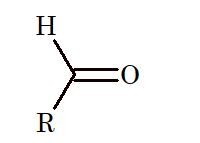
(b) Ketones: They can be further classified as simple or mixed ketones depending upon the groups attached.

Where R and R1 can be an alkyl or aryl group.
In carbonyl compounds both carbon and oxygen are sp2 hybridized with π electron displaced towards oxygen atom.
METHODS OF PREPARATION
From Alkenes
(i) Ozonolysis: Alkenes are subjected to ozonolysis and subsequent reduction to produce aldehydes and ketones.
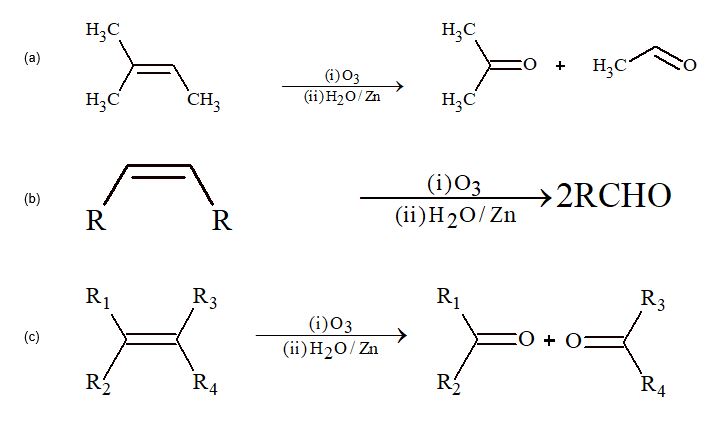
This method is used only for aliphatic carbonyl compounds.
(ii) Oxo process: This method is used to convert terminal alkenes into carbonyl compounds.
(iii) Wacker process:
From Alkynes:
(i) By hydration of alkynes:
From Halides
(a)

From Alcohols
(i) Primary alcohols:
(a)
(b)
Only aldehydes are formed from primary alcohols.
(ii) Secondary alcohols: Only ketones can be formed from secondary alcohols.
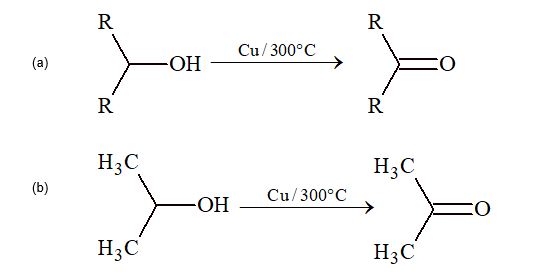
(iii) Oppenauer oxidation:
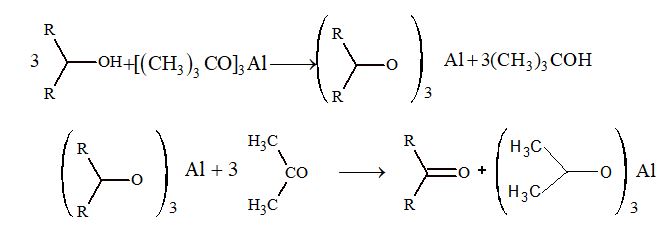
Unsaturated alcohols can be oxidized

Tertiary alcohols do not react
Oxidation of vic. diols (periodic acid or lead tetra acetate oxidation)

Illustration 1:
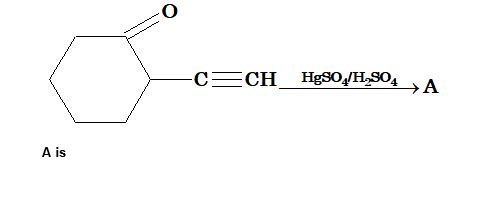
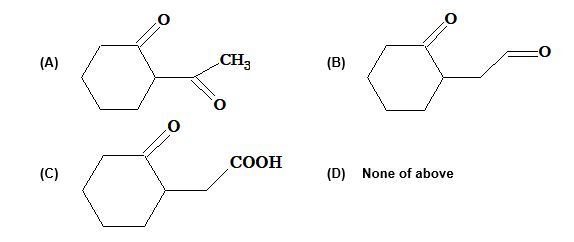
Solution. (B). C = O is electron withdrawing group hence π electron transfer is towards ring.
Illustration 2: Which of the following has the highest dipole moment?
(A) aldehydes and ketones
(B) ethers
(C) carbon tetrachloride
(D) alcohols
Solution: (A). Since the p-electrons between C and O are less tightly held, therefore, oxygen in aldehydes carries a negative charge than oxygen in ethers and alcohols, therefore, dipole moment of aldehydes and ketones is higher than those of alcohols, ethers and CCl4 (μ= 0).
From Carboxylic Acids
(i) Decarboxylation of calcium salts of carboxylic acid:
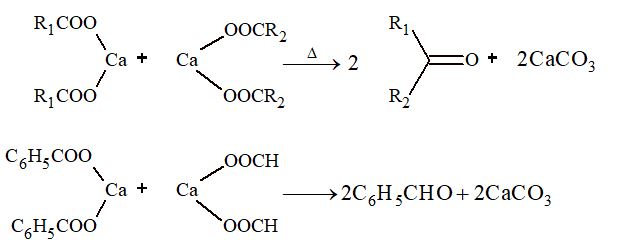
ii) Decomposition of carboxylic acids:

Case –I, when both the reactants are HCOOH.

Case – II when one of the reactant is HCOOH.

Case – III
CH3COOH + CH3CH2COOH CH3 CH2CH3 +CO2 + H2O
From Acid Chlorides
(i) Preparation of ketones:

(ii) Rosenmund’s reaction: Acid chlorides on partial reduction in presence of Lindlar’s catalyst give aldehydes.
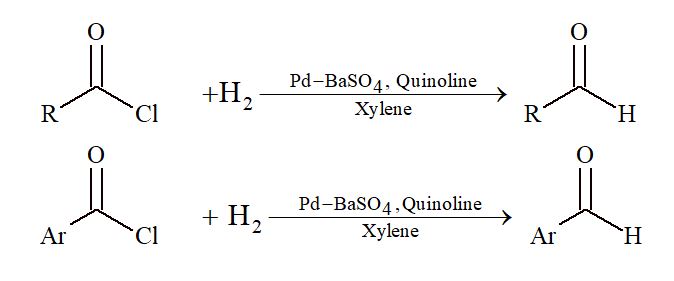
Reaction with Alkyl Lithium
Mechanism:
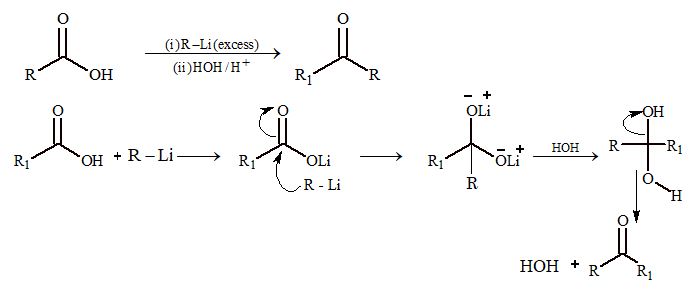
From Cyanides
Stephen reduction:
(i)
(ii)
Mechanism:
From Grignard Reagent
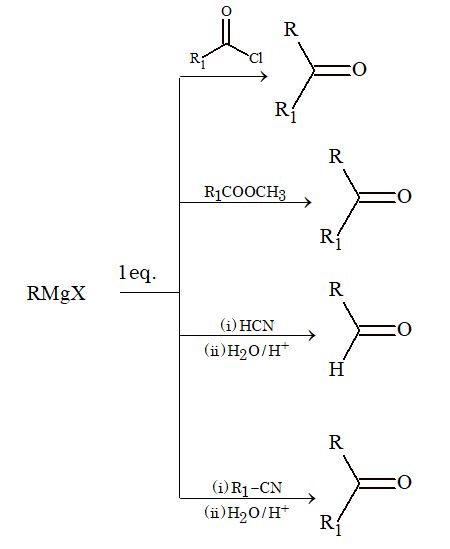
Preparation of Aromatic Carbonyl Compounds
(i) From methyl arenes:
(ii) From chloromethyl arenes:
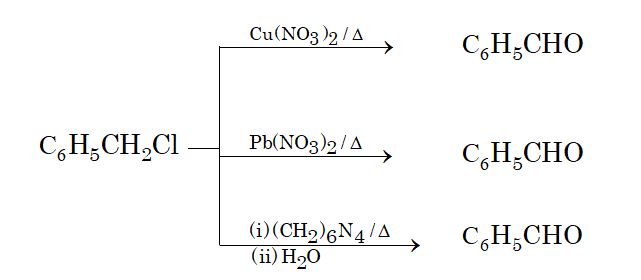
(iii) From benzene:
Gattermann – Koch formylation

Illustration 3: 1 Phenyl ethanol can be prepared by reacting benzaldehyde with
(A) methyl bromide
(B) ethyl iodide and magnesium
(C) methyl bromide and aluminium
(D) methyl iodide and magnesium
Solution: (D). CH3I+Mg → CH3MgI
Illustration 4: Reaction between (C2H5)2Cd and CH3COCl leads to the formation of
(A) dimethyl ketone
(B) ethyl methyl ketone
(C) diethyl ketone
(D) acetaldehyde
Solution: (B)
PHYSICAL PROPERTIES
1. Aldehydes and ketones have higher boiling points than hydrocarbons of similar molecular weight due to the presence of polar carbonyl group. But aldehydes and ketones have lower boiling point than corresponding alcohols due to lack of intermolecular hydrogen bonding.
2. They are soluble in polar solvents like H2O due to hydrogen bonding.
3. Some aromatic aldehydes have pleasant fragrance.
CHEMICAL PROPERTIES
The reactions of aldehydes and ketones can be broadly divided into two types depending upon the part of molecule involved in the reaction. The types are,
1. Reactions due to carbonyl group
(a) Addition reaction
(b) Oxidation
(c) Reduction
2. Reactions due to α → hydrogen
(a) Condensation reactions
(b) Halogenation
REACTIONS DUE TO CARBONYL GROUP
Addition Reactions:
These are characterized by the nucleophilic attack on the carbon of the carbonyl group.
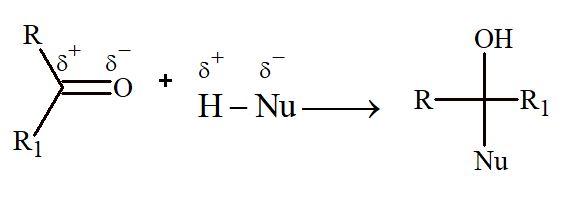
(i) Addition of HCN:
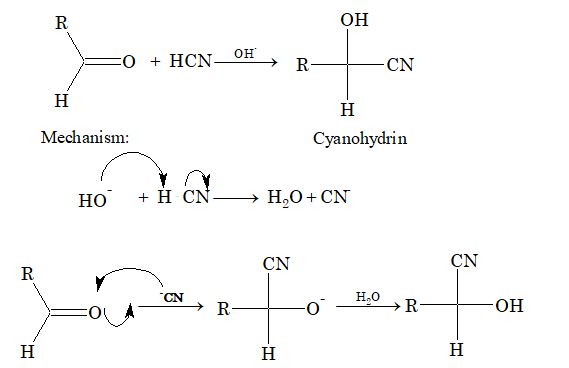
(ii) Addition of NaHSO3:

This reaction is used for purification of aldehydes and ketones, but ketones which are sterically hindered cannot be purified.

(iii) Addition of alcohols: Addition of alcohols to carbonyl compounds is catalysed by acid or base.
Case – I: This reaction leads to the formation of hemiacetal or ketal.
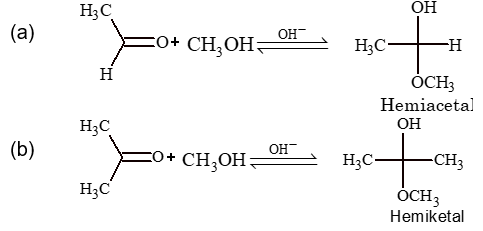
Case – II: Addition is catalysed by acid. It results in the formation of acetal and ketal.
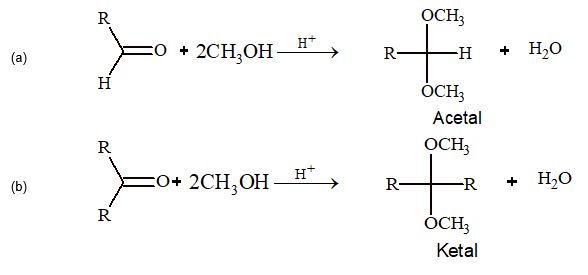
[Note: (i) There is always an equilibrium between the reactants and products. If byproduct water is removed the reaction becomes irreversible.
(ii) Reaction is used to protect carbonyl group.]

So, alcohols are used as protecting groups of carbonyl compounds in basic and neutral medium.
(iv) Addition of Grignard reagent: Used for the preparation of 1°, 2° and 3° alcohol.
 (v)
(v)
Ethinylation: The addition of terminal alkynes to the carbonyl compound.
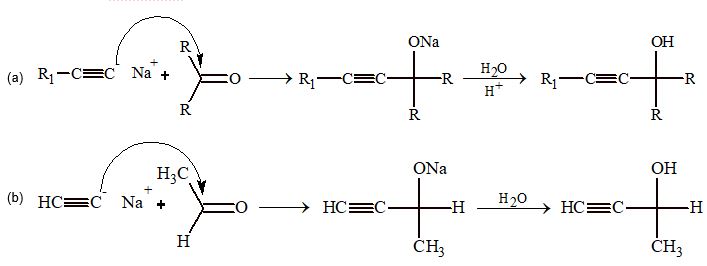
(vi) Addition of ammonia and ammonia derivatives:
In these reactions adducts are formed by primary amines and derivatives of ammonia undergoes elimination to give imine .
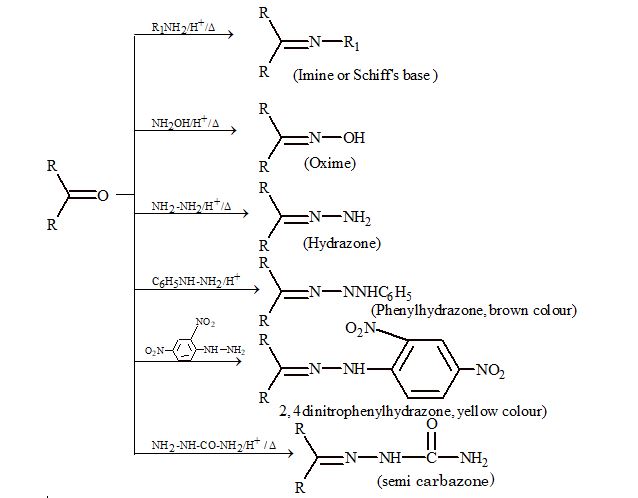
[Note: Schiff’s base can be used to differentiate between aldehydes and ketones. Schiff’s base is pink in colour and is decolourized by the passage of SO2.]
Illustration 5: Purification of aldehydes and ketones is done by NaHSO3, except for the
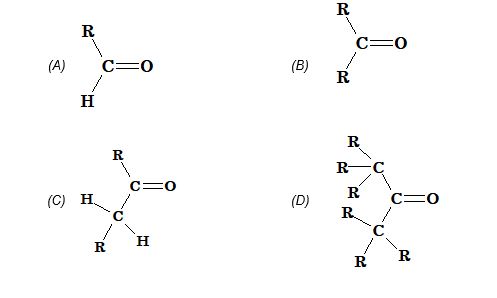
Solution: (D)
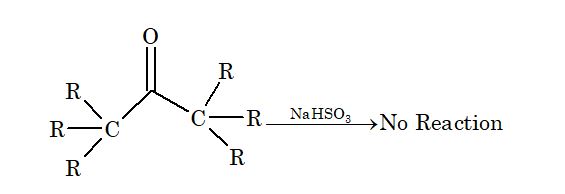
Ketone is sterically hindered.
Illustration 6: Which of the following will react at the slowest rate with a nucleophile?
(A) Methanal
(B) Butanone
(C) 2-pentanone
(D) 3-pentanone
Solution: (D). If the electrophilic character of carbon is considerably reduced, then the reaction will be slow.
Oxidation:
1. Oxidation by mild oxidizing agents: They oxidize aldehydes to carboxylic acids. They can’t oxidize ketones.
(i) Fehling’s solution: It is an alkaline solution of cupric ion complexed with sodium potassium tartrate ions.

(ii) Benedict’s solution: It is an alkaline solution of cupric ion complexed with sodium potassium citrate ions and the reaction is same as above.
[Note: Above two reagents oxidize only aliphatic aldehydes.]
(iii) Tollen’s reagent: It is an ammonical silver nitrate solution. It oxidizes only aliphatic aromatic aldehydes.
R – CHO + Ag+ ¾→ RCOOH + Ag(silver mirror)
[Note: This reagent does not oxidize carbon – carbon multiple bonds.]
2. Oxidation by strong oxidising agents: The below mentioned oxidizing agents can oxidize both aldehydes and ketones to carboxylic acids. The reagents are,
(i) KMnO4/OH–
(ii) KMnO4 / H+/Δ
(iii) K2Cr2O7/H+/Δ
(iv) conc. HNO3/Δ
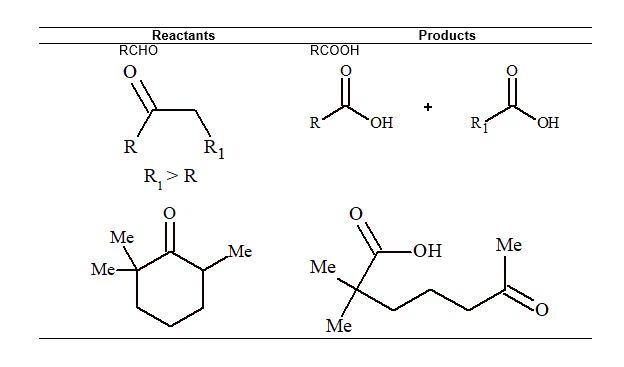
3. Important oxidation reactions:
(i) Haloform reactions:

(ii) Oxidation by SeO2:
SeO2 oxidises α→CH2 group into keto group and α→CH3 group into aldehydic group.
(iii) Baeyer– Villiger oxidation:
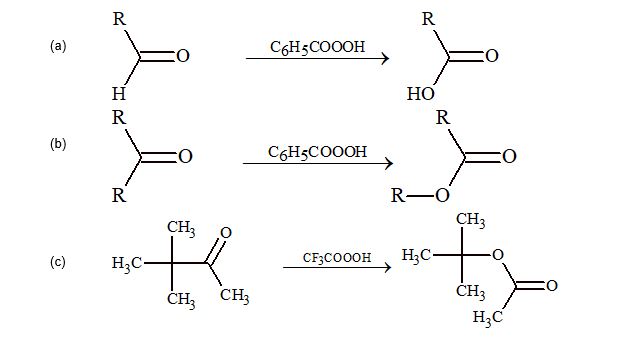
Reduction:
The reduction of carbonyl compounds can be carried out by using various reducing agents. The different reactions are tabulated below:
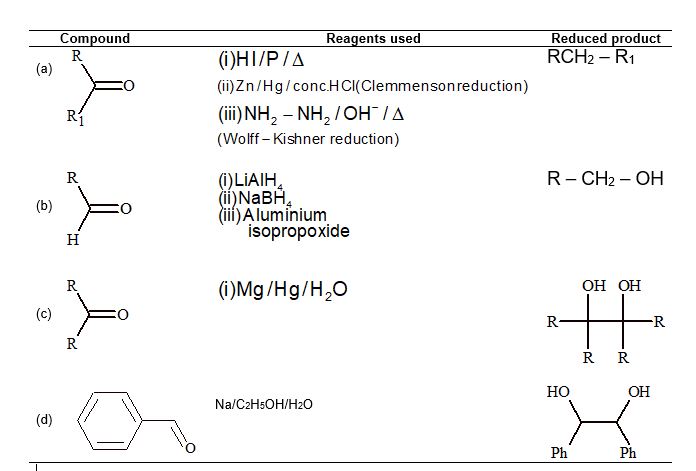
Illustration 7: Which of the following will not give iodoform test?
(A) Ethanal (B) Ethanol (C) 2-pentanone (D) 3-pentanone
Solution: (D). 3-pentanone (CH3-CH2-CO-CH2-CH3) does not contain CH3CO group, hence does not give iodoform test.
Illustration 8: In which of the following reactions, aldehydes and ketones are distinguished?
(A) Reaction with phenylhydrazine
(B) Reaction with hydroxylamine
(C) Reaction with semicarbazide
(D) Reaction with silver nitrate mixed with ammonia
Solution: (D). Phenylhydrazine, hydroxylamine and semicarbazide react with aldehydes and ketones while AgNO3/NH3 (Tollen’s reagent) reacts only with aldehydes but not with ketones.
Illustration 9: The best oxidizing agent for oxidation of CH3CH = CHCHO to CH3CH=CH—COOH is
(A) acidified KMnO4
(B) alkaline KMnO4
(C) acidified K2Cr2O7
(D)
Solution: (D). It is a specific oxidizing agent.
Illustration 10: Which of the following reduces Tollen’s reagent?
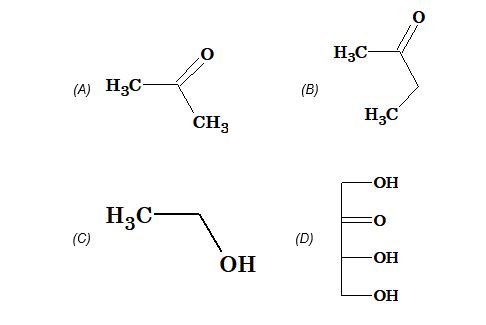
Solution: (D). Tollen’s reagent is reduced by (i) HCOOH (ii) Aldehydes and (iii)a hydroxy ketones.
Reactions due to α–hydrogens:
α–hydrogen of carbonyl compounds is acidic in nature.

Halogenation:
Carbonyl compounds undergo acid or base catalysed halogenation.
(a) Acid catalysed halogenation

(b) Base catalysed halogenation

Alkylation by Lithium Enolates:

1. α – hydrogen of carbonyl compound is acidic in nature and reacts with base.
2. The enolate ion formed is stabilized by resonance.
3. Keto form is generally more stable than enol form.
Condensation Reactions:
The general steps of condensation reaction are
Step – I: Base removes acidic hydrogen to form carbanion.
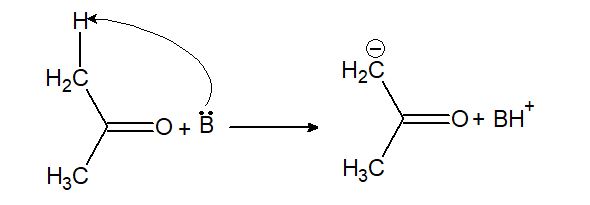
Step – II: The carbanion formed acts as a nucleophile and attacks carbon atom of other carbonyl compound.

Step – III: Acceptance of proton.

Step – IV: Formation of conjugate bond will bring stabilization, so dehydration occurs.

(i) Aldol condensation: Two molecules of carbonyl compounds undergo condensation, where at least one of them possesses acidic hydrogen, i.e. α – H and reaction is carried out in presence of dilute base or dilute acid. The product formed is β – hydroxy carbonyl compound, which is also known as aldol.
CH3CHO + C2H5CHO CH3CH2CH = CHCHO
Mechanism:
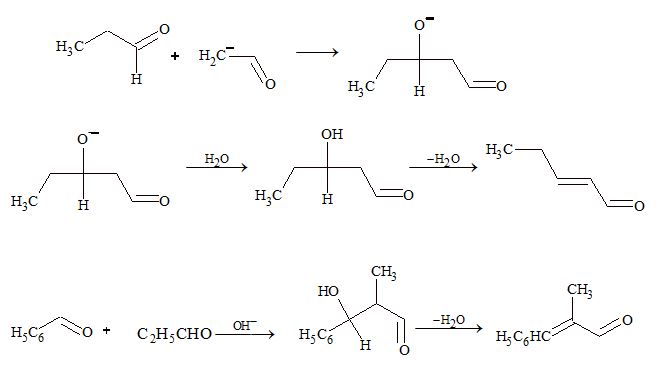
Intramolecular aldol condensation:

Illustration 11: Which of the following will be most readily dehydrated in acidic conditions?
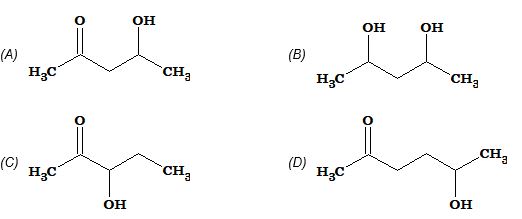
Solution: (A). Aldols, i.e. β-hydroxyaldehydes or β-hydroxyketones readily undergo dehydration to form α, β unsaturated aldehydes or ketones.

Illustration 12: Aldol condensation, between which of the following compounds followed by dehydration gives methyl vinyl ketone?
(A) Formaldehyde and acetone
(B) Formaldehyde and acetaldehyde
(C) Two molecules of acetaldehyde
(D) Two molecules of acetone
Solution: (A)

Illustration 13: 3HCHO + CH3CHO A
A can be
(A) reduce Tollen’s reagent
(B) give Cannizzaro reaction
(C) react with Na
(D) All of the above
Solution: (D). A is formed by aldol condensation. The structure of A is
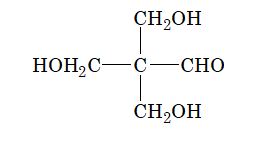
(ii) Cannizzaro reaction: In the presence of concentrated alkali, aldehydes containing no a-hydrogens undergo self-oxidation and reduction to yield a mixture of an alcohol and a salt of a carboxylic acid. This reaction is known as Cannizzaro reaction.
Mechanism:
In Cannizzaro reaction two successive additions are involved.
(a) Addition by hydroxide ion in first step
(b) Addition of hydride ion in the next step
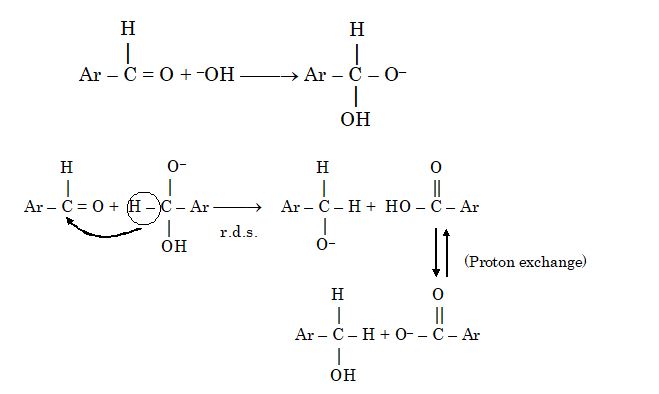
In crossed Cannizzaro reaction, two different aldehydes having no a-hydrogen atoms are involved.
ArCHO + HCHO → HCO2Na+ + ArCH2OH
(iii) Claisen–Schmidt reaction: Condensation of an aromatic aldehyde and aliphatic ketone.

(iv) Perkin’s condensation: This condensation occurs between aromatic aldehyde and aliphatic acid anhydride having at least two α – hydrogen atoms.

Mechanism:
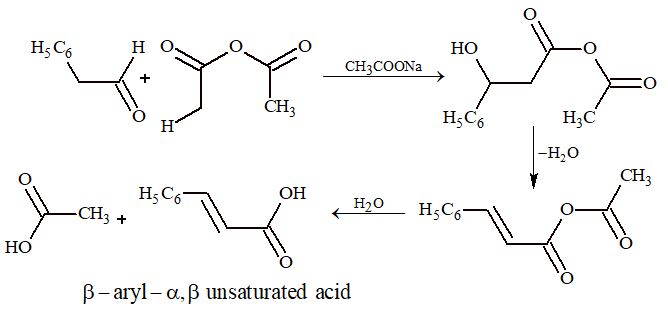
(ii) Knoevenagel Reaction: This reaction occurs between aromatic aldehyde and compounds having active methylene group. Reaction is catalysed by weak base, e.g. pyridine or piperidine.

Mechanism:
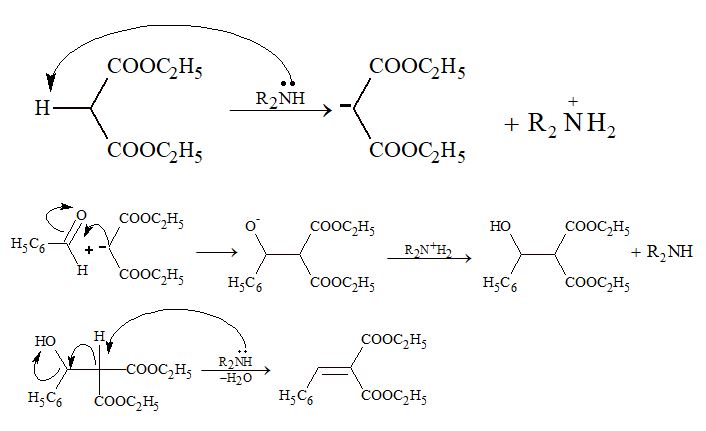
Illustration 14: A mixture of (CH3)3CCHO and HCHO on heating with aqueous NaOH solution will give
(A) HCOONa + (CH3)3CCH2OH
(B) (CH3)3CCOONa + CH3OH
(C) HCOONa + (CH3)3CCOONa
(D) CH3OH + (CH3)3C – CH2OH
Solution: (A). Cross-cannizzaro reaction will occur. The carbonyl carbon of formaldehyde being most electrophilic, or most ideal for nucleophilic attack. OH– ion (nucleophile) will attack formaldehyde, the product will then donate H– to (CH3)3CCHO. Thus, formaldehyde will be oxidized to HCOONa and (CH3)3C CHO will be reduced to (CH3)3CCH2OH.
FORMULAE AND CONCEPTS AT A GLANCE
1. Secondary alcohols can be acidised to ketones by using Aluminium t-butoxide (oppenauer oxidation). In this oxidation even unsaturated 20 alcohols can be oxidised to ketone without affecting the double bond.
2. In Rosenmund’s reduction, poisoning of Pd with BaSO4 prevents reduction of RCHO to RCH2OH.
3. Oxidising toluene with chromyl chloride or CrO3 in presence of acetic anhydride (Etard reaction) to trap benzaldehydes as benzylidene acetate and thus avoid its oxidation to benzoic acid.
4. Aromatic compounds can be converted to aldehydes n the presence of 20 amine and formic acid (Vils meyer reaction).
5. The reaction of RMgX with RCOCl cannot be used for the preparation of ketones because the Grignard’s reagent can further react with carbonyl compounds forming alcohol.
6. Aromatic aldehydes are lesss reactive than aliphatic aldehydes.
7. Benzophenone does not react with HCN. Also aromatic ketones do not react with NaHSO3.
8. Halogenation (with moist Cl2 or Br2) taken place more readily in aldehydes/ketones than in alkanes.
9. Aldehydes except benzaldehyde reduce Fehling’s solution.
10. Aldol condensation involves the formation of carbonion as intermediate.
SOLVED PROBLEMS-1
Prob 1: 
What is Z in this reaction?
Sol: 
Prob 2: What will be the intermediates A and B in the following reaction

Sol:
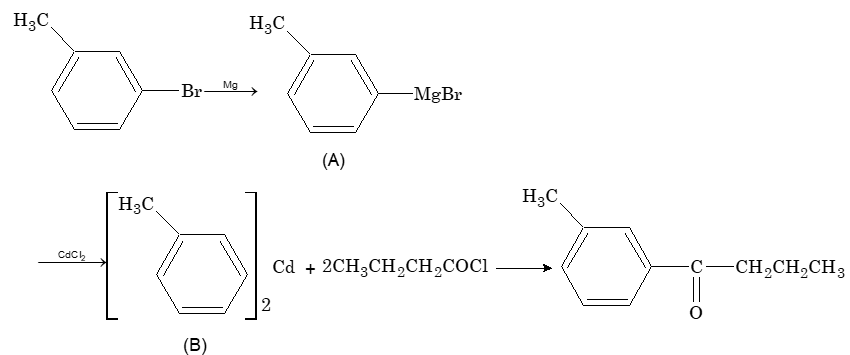
Prob 3: What will be formed when calcium acetate is distilled with calcium formate?
Sol: Methanal, Propanone and ethanal will be the main product when calcium acetate is distilled with calcium formate.
Prob 4: What is X in the following reaction
Sol:
is conjugate system

Prob 5: What is the end product in the following sequence of reaction
Sol:
Prob 6: X and Y (Y is alcohol, D is deuterium). What will be the structure of X and Y?
Sol:

Prob 7: In Cannizzaro reaction given below
What is the slowest step
Sol: Transfer of hydride ion to the carbonyl group is the slowest or the rate determining step.

Prob 8: When metachloro benzaldehyde is treated 50% KOH solution, what are the product(s) in this reaction
Sol: 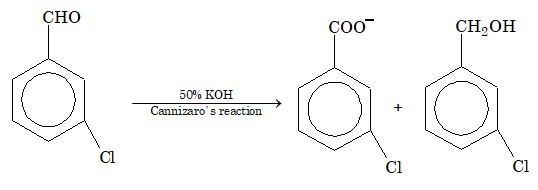
Prob 9: Using C6H5MgBr which substrate would lead to (C6H5)3COH?
Sol:
Prob 10: Why only RCHO. RCOCH3 and cylic ketone react with NaHSO3?
Sol: is a large ion. Its addition is possible only under the conditions that > C = O grouping is not sterically hindered as is the case for RCHO, RCOCH3 and cyclic ketones.
SOLVED PROBLEMS-2
Prob 1: A will
(A) reduce Tollen’s reagent
(B) gives FeCl3 test
(C) gives bromine water test
(D) gives benzoin condensation
Sol: (A). Since, A has an aldehyde group, so it reduces Tollen’s reagent.
Prob 2: When aldehyde is heated with Fehling’s solution, it gives a precipitate of
(A) Cu (B) CuO (C) Cu2O (D) Cu + Cu2O + CuO
Sol: (C). Copper sulphate is reduced to Cu2O.
Prob 3: Which of the following gives positive iodoform test and positive Fehling’s solution test?
(A) Acetone (B) Acetaldehyde (C) Ethanol (D) Formaldehyde
Sol. (B). Acetaldehyde has CH3CO – group as well as – CHO group.
Prob 4: The most appropriate reagent for the conversion of 2pentanone to butanoic acid is
(A) sodium hypoiodite
(B) O2
(C) acidified KMnO4
(D) alkaline KMnO4
Sol: (A). Haloform reaction converts methyl ketones to acids directly.
Prob 5:

The product is
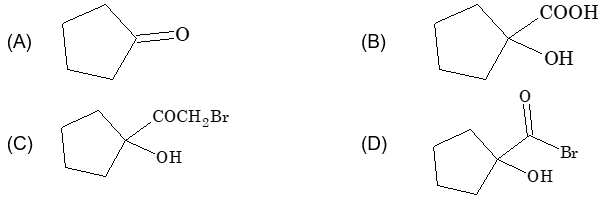
Sol: (B)

Prob 6: Aliphatic and aromatic aldehydes can be differentiated by the use of
(A) Fehling solution
(B) Tollen’s regent
(C) KMnO4/H+/ D
(D) conc. HNO3/D
Sol: (A). Aromatic aldehydes are less reactive than aliphatic halides in nucleophilic addition reaction and can be distinguished by Fehling solution.
Prob 7: Aldol condensation will not be observed in
(A) chloral (B) phenylacetaldehyde (C) hexanal (D) none of the above
Sol: (A). Chloral does not contain hydrogen atom, hence does not undergo aldol condensation. Instead it undergoes hydrolysis to give CHCl3.
Prob 8: Which of the following aldehydes is most reactive towards nucleophilic addition reaction?
(A) HCHO (B) CH3CHO (C) C2H5-CHO (D) CH3-COCH3
Sol: (A). HCHO is most reactive towards nucleophilic addition reaction.
Prob 9: Cinnamic acid is formed when C6H5CHO condenses (CH3CO)2O in presence of
(A) conc. H2SO4 (B) sodium acetate (C) sodium metal (D) anhydrous ZnCl2
Sol: (B).

Prob 10: When acetone is heated with conc. H2SO4, the product formed is
(A) mesityl oxide (B) phorone (C) mesitylene (D) diacetone alcohol
Sol: (C). With conc. H2SO4 three molecules of acetone condense to form 1,3,5 trimethyl benzene or mesitylene.








